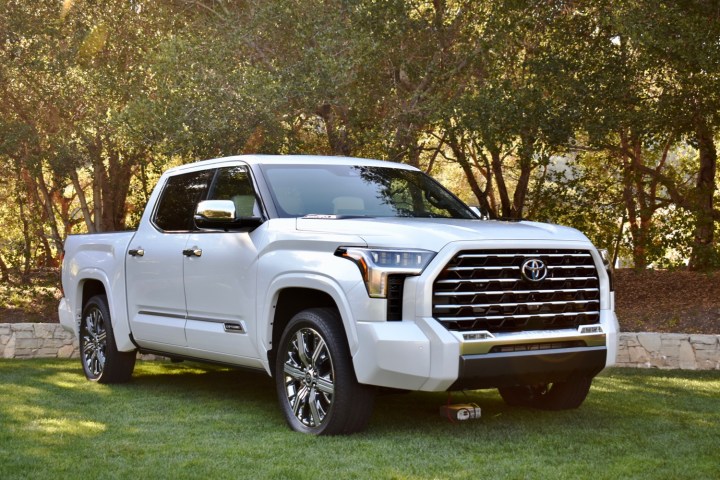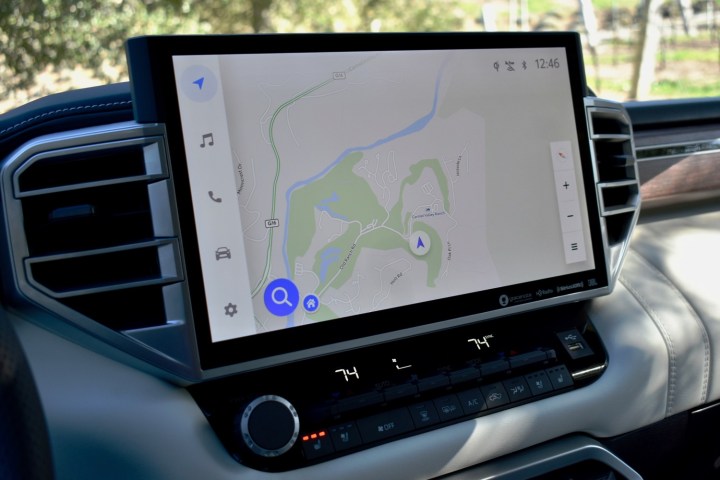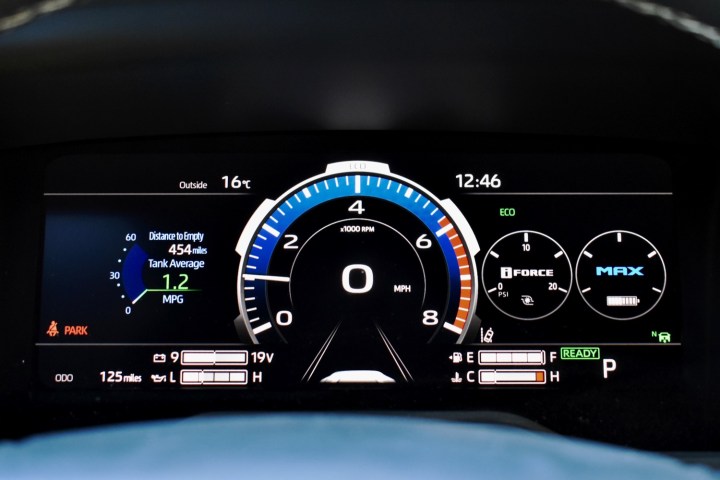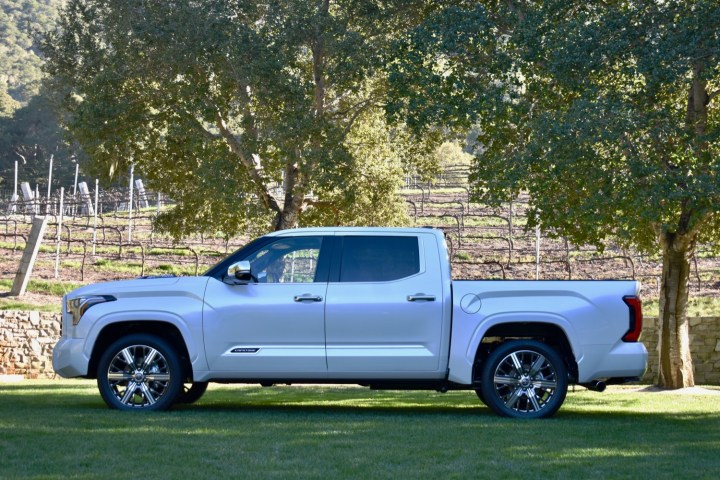
Toyota has done more than any other automaker to popularize hybrid cars. Japan’s largest automaker may not have been the first to bring a hybrid to the United States (that was Honda), but the Toyota Prius made the idea stick — and it didn’t end there. Over the last decade, Toyota built on the popularity of the Prius, adding hybrid powertrains to nearly every type of vehicle.
One of the most glaring gaps in Toyota’s hybrid lineup has been pickup trucks, in part because Toyota hasn’t bothered to give its Tundra pickup a full redesign since the 2007 model year. In the meantime, Ford beat Toyota off the line with its 2021 F-150 PowerBoost hybrid. For the 2022 model year, Toyota aims to make up lost ground with the Tundra i-Force Max hybrid.
The name may sound a bit dorky, but Toyota claims its first Tundra hybrid will offer the towing and hauling capability of a traditional full-size pickup truck while delivering better gas mileage than the defunct V8-engined Tundra. The question is whether the 2022 Toyota Tundra i-Force Max can balance those competing demands. Is it the Prius of pickups, or a weak-sauce hybrid?
To find out, we spent a day driving different Tundra hybrid models on and off-road in California. The i-Force Max powertrain isn’t available on base Tundra trim levels. It’s optional on the Limited, Platinum, and 1794 models, and standard on the TRD Pro off-road model and new-for-2022 Tundra Capstone. The least-expensive hybrid model is the rear-wheel-drive Limited, which starts at $53,995 (all prices include a mandatory $1,695 destination charge). The price range goes up to $75,225 for the top Tundra Capstone trim level.
Design and interior
For the Tundra’s first redesign in over a decade, Toyota went all-out. The 2022 Tundra tries so hard to outdo its American rivals on aggressive, rugged styling that it almost descends into self-parody. The massive grille, scowling headlights, and muscular body-side sculpting that would make a Men’s Health cover model blush all combine for visual overload. Most trim levels ladle a decent helping of chrome on top of that, including 22-inch wheels on the top Capstone model.
Like rival full-size pickup trucks, the Tundra retains the body-on-frame construction that was abandoned by passenger cars long ago. The 2022 model rides on a new frame that’s fully boxed to improve structural rigidity, while the bed is made from a mix of aluminum and sheet molded compound to save weight.
The 2022 Tundra tries so hard to outdo its American rivals on aggressive, rugged styling that it almost descends into self-parody.
Like most trucks, the Tundra is available in multiple cab and bed-length configurations, but not all of them can be combined with the hybrid powertrain. You can’t get it with the Double Cab, which also means you can’t order the longest 8.1-foot bed. However, that still leaves the more spacious CrewMax four-door crew cab and 5.5-foot or 6.5-foot bed options. Front and rear headroom are pretty close to a crew-cab Ford F-150, but the Ford offers more legroom in both rows.
Aside from the more rugged TRD Pro, all Tundra hybrid trim levels aim to be at least somewhat luxurious. Most get standard leather seats, while the Capstone model gets semi-aniline leather upholstery and walnut trim. However, even the Capstone had some cheap-looking plastic trim, and it’s hard to distinguish the different luxury Tundra models from each other. Aside from color palette, the interiors of the Platinum, 1794 (named for the founding year of the Texas ranch where Toyota’s truck factory is located), and Capstone look pretty similar. You don’t get the sense that you’re ascending to higher levels of luxury as you climb the pricing ladder.
Tech, infotainment, and driver assist
All hybrid models get a 14.0-inch touchscreen (non-hybrid models get a smaller screen as standard equipment) and 12.3-inch digital instrument cluster, with wireless Apple CarPlay and Android Auto. The Tundra is the first model to get Toyota’s new Audio Multimedia infotainment system, which was developed in the United States and adds features like natural-language voice recognition, cloud-based navigation, Apple Music/Amazon Music integration, and over-the-air updates. A 10.0-inch head-up display is also available.
We were impressed by the large touchscreen’s simple and sensible menu layout. The clear, easy-to-read graphics didn’t reflect the rest of the truck’s tough design aesthetic. Plus, a screen this big feels right-sized in such a large vehicle. Toyota also crammed an impressive amount of information into the digital instrument cluster while still keeping things legible.
We were impressed by the large touchscreen’s simple and sensible menu layout.
Toyota also offers some tech designed to make towing easier. Trailer Back Guidance will automatically steer while backing up with a trailer and provides guide arrows on the touchscreen display so you know which way the trailer will turn before you start moving. Straight Path Assist does essentially the same thing, but specifically when backing up in a straight line. Like Ford, Toyota also offers blind-spot monitoring that can cover a trailer.
The standard Toyota Safety Sense 2.5 package includes forward-collision warning (with pedestrian detection), adaptive cruise control, lane-departure warning, Lane Tracing Assist automated lane centering, traffic-sign recognition, automatic high beams, and a rear-seat reminder. Blind-spot monitoring and rear cross-traffic alert are optional. That covers all the bases, but Toyota doesn’t offer anything to rival the BlueCruise driver-assist system available in the Ford F-150.
Driving experience
The hybrid powertrain starts with the twin-turbocharged 3.5-liter V6 and 10-speed automatic transmission from the standard Tundra. Toyota then adds an electric motor and clutch within the bell housing of the transmission, as well as a nickel-metal hydride battery pack under the rear seats. This is actually more like the configuration used by Ford than anything from Toyota’s existing hybrid catalog. That’s because, unlike Toyota’s other hybrid systems, the i-Force Max prioritizes torque for towing over outright fuel economy. The electric motor does most of its work only at speeds below 18 mph, in fact. Like the standard Tundra, the hybrid is available with rear-wheel drive or four-wheel drive.
Total system output is 437 horsepower and 583 pound-feet of torque, which is more than you get from the non-hybrid Tundra powertrain. It’s also more than the Ford F-150 hybrid’s 430 hp and 570 lb-ft of torque, but just barely. At any rate, it’s more than enough power for a big truck. We were impressed by how easily the Tundra got up to speed for highway merges and the linear feel of its acceleration. The powertrain made a smooth transition from electric to gasoline propulsion in most situations, although we did notice a bit of roughness when rolling on and off the accelerator pedal in stop-and-go traffic.
Despite having “Max” in its name, the i-Force Max isn’t the top Tundra when it comes to towing and hauling. The hybrid’s 11,450-pound maximum towing capacity is impressive, but a little less than the 12,000 pounds Toyota quotes for the non-hybrid Tundra (in rear-wheel drive SR5 Double Cab form). The Tundra hybrid also doesn’t achieve the 1,940-pound payload capacity of some non-hybrid Tundra models. The Ford F-150 PowerBoost hybrid, meanwhile, has a slight advantage over the Tundra, with a 12,700-pound towing capacity.
The Tundra felt like an old truck, not something fresh off the drafting board.
The 2022 Toyota Tundra also gets multi-link rear suspension with coil springs in place of the old model’s leaf springs, a technology that dates back to the stagecoach. This improves ride quality without sacrificing towing capacity, according to Toyota. It also allowed Toyota to equip high-end versions of the Tundra with adaptive dampers (for an even smoother ride) and rear air springs. These can be raised to increase ground clearance, lowered to improve bed access, and self-level to accommodate heavy loads.
None of these features made much of a difference in the driving experience, however. The Tundra felt like an old truck, not something fresh off the drafting board. It bounced uncontrollably over some bumps, while others send shudders through the frame and body. The steering felt too loose and imprecise to elicit confidence, and we noticed more wind noise than in other trucks — although the Capstone model’s acoustic glass helped with this. A big pickup is never going to ride as smoothly as a luxury sedan, but other trucks — including the Ford F-150 — have shown that greater levels of refinement are possible.
Toyota offers a TRD Off-Road Package, as well as a dedicated TRD Pro off-road model. We drove the latter on a short course set up by Toyota and found it pretty capable. However, Toyota’s Crawl Control, which automatically maintains a set speed in off-road conditions, didn’t have the smoothest operation. A truck this big also doesn’t leave much room for error on narrow trails.
Gas mileage and safety
In the all-important fuel-economy competition, Toyota estimates 22 mpg combined (20 mpg city, 24 mpg highway) with rear-wheel drive and 21 mpg combined (19 mpg city, 22 mpg highway) with four-wheel drive (TRD Pro models get 20 mpg combined). The 2022 Ford F-150 hybrid is officially rated at 25 mpg in all three categories with rear-wheel drive and 23 mpg across the board with four-wheel drive, so it has a small lead over the Tundra.
These figures also represent improvements of just one or two mpg over the non-hybrid Tundra in most categories. It’s a similar story with the F-150, but shows that towing is the priority here, not gas mileage.
Toyota offers a three-year, 36,000-mile basic warranty and a five-year, 60,000-mile powertrain warranty — the same terms offered by Ford, Chevrolet, and Ram on their big pickups.
Crash-test ratings from the Insurance Institute for Highway Safety (IIHS) and National Highway Traffic Safety Administration (NHTSA) weren’t available at the time of publication. That’s not unusual for redesigned models.
How DT would configure this car
Choosing a Tundra i-Force Max trim level depends on whether you plan on going off-road regularly. The TRD Pro model adds a locking rear differential, hill-descent control, terrain-based drive modes, internal bypass shock absorbers, a front skid plate, and all-terrain tires, making it the best Tundra for off-road enthusiasts.
Unless you plan on doing recreational off-roading, it’s not really worth paying for those extra features. Similarly, we weren’t sold on the Tundra Capstone or 1794 models. Because every Tundra hybrid gets the 14.0-inch touchscreen, they don’t really add anything in terms of tech. While they are intended to be the most luxurious Tundra models, the differences between them and the lower-level Platinum model are mostly cosmetic and don’t justify the price premium.
However, we would upgrade from the base Limited trim level to the Platinum, because the latter gets leather seats and the Trailer Back Guidance and Straight Path Assist driver aids as standard equipment. We would also check the box for the optional 10.0-inch head-up display.
Our take
The 2022 Toyota Tundra i-Force Max is a good truck, but it doesn’t advance the state of the art. Instead of breaking new ground, Toyota’s first hybrid pickup competently executes ideas we’ve already seen from other truck makers.
From its in-your-face styling to its focus on luxury trim levels, the Tundra follows trends rather than creates them. Toyota’s new infotainment system works well enough, but the Tundra doesn’t offer any standout tech features competitors don’t have. That also goes for the Trailer Back Guidance and Straight Path Assist towing aids. They work well, but not any better than Ford’s Pro Trailer Backup Assist.
Toyota has more experience with hybrids than any other automaker, but the i-Force Max powertrain doesn’t surpass Ford’s PowerBoost in towing or fuel economy. The emerging crop of electric trucks, like the Rivian R1T and Ford F-150 Lightning, could provide a better alternative to the truly eco-minded, although towing can severely limit an EV’s range.
So while the Tundra performs its intended function well, it doesn’t stand out from other full-size pickup trucks. That could change if the new model can match its predecessor’s legendary reliability, but it’s too early to tell.
Should you get one?
No. The Tundra i-Force Max has some good qualities, but it doesn’t move the truck game forward.








